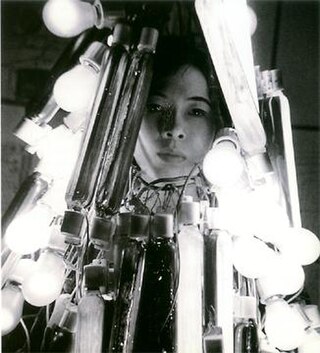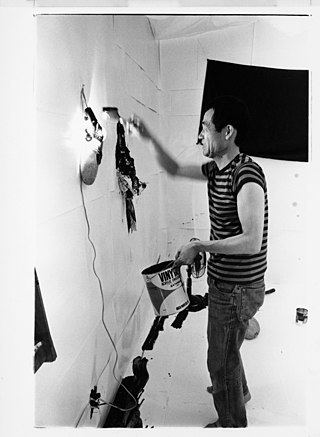Related Research Articles
The Gutai Art Association was a Japanese avant-garde artist group founded in the Hanshin region by young artists under the leadership of the painter Jirō Yoshihara in Ashiya, Japan, in 1954. It operated until shortly after Yoshihara's death in 1972.

Jirō Yoshihara was a Japanese painter, art educator, curator, and businessman.

Atsuko Tanaka was a Japanese avant-garde artist. She was a central figure of the Gutai Art Association from 1955 to 1965. Her works have found increased curatorial and scholarly attention across the globe since the early 2000s, when she received her first museum retrospective in Ashiya, Japan, which was followed by the first retrospective abroad, in New York and Vancouver. Her work was featured in multiple exhibitions on Gutai art in Europe and North America.
Takesada Matsutani is a Japanese avant-garde artist based in Paris and Nishinomiya. Active as a painter since the 1950s, Matsutani's practice has also included object-based sculpture, printmaking and installation. Matsutani was a member of the Gutai Art Association from 1963 until its dissolution in 1972. Gutai leader Jirō Yoshihara prioritized artistic innovation and originality, a lesson that has remained with the artist throughout his career.
Yō Akiyama is a Japanese ceramicist based in Kyoto. He was a late leading figure of Sōdeisha, an avant-garde ceramicist group that reimagined ceramics as nonfunctional sculptural practice. Akiyama studied directly under Kazuo Yagi, one of the founders of Sōdeisha, for six years. He later became a professor at Kyoto Municipal University of Arts and Music, where he is currently a Professor Emeritus, having retired in 2018. As an artist, he works primarily with black pottery, a technique that fires clay in low temperature, smoky conditions to create a dark effect. His predominantly largescale work is richly textural and abstract, emphasizing the earthy materiality of the work as well as its form.

Matsuda Yuriko is a Japanese ceramic artist.
Minoru Onoda was an important member of the Gutai Group's younger generation having joined the group in 1965. His 'Paintings of Propagation' theory was a crucial step in his early career. He was included in the important retrospectives on the Gutai Group at the Solomon R. Guggenheim Museum in New York in 2013 and the National Art Center in Tokyo in 2012. The 2022 Gutai retrospectives 'Into the Unknown World – GUTAI: differentiation and Integration', National Museum of Art, Osaka, and Nakanoshima Museum of Art, Osaka, JP included many of his works.

Yuko Nasaka is a Japanese avant-garde artist who is known for her involvement with the Gutai Art Association.
Saburo Murakami was a Japanese visual and performance artist. He was a member of the Gutai Art Association and is best known for his paper-breaking performances (kami-yaburi) in which he burst through kraft paper stretched on large wooden frames. Paper-breaking is a canonical work in the history of Japanese post-war art and for the history of performance art. Murakami’s work includes paintings, three-dimensional objects and installation as well as performance, and is characterized by a highly conceptual approach that transcends dualistic thinking and materializes in playful interactive forms and often thematizes time, chance and intuition.
Tsuruko Yamazaki was a Japanese artist, known for her bold artistic experiments with abstract visual styles and non-traditional materials. She was a co-founder and the longest-standing female member of the Gutai Art Association, an avant-garde artists' collective established by Jirō Yoshihara.

Jennifer Elizabeth Lee is a Scottish ceramic artist with an international reputation. Lee's distinctive pots are hand built using traditional pinch and coil methods. She has developed a method of colouring the pots by mixing metallic oxides into the clay before making. Her work is held in over forty museums and public collections worldwide, including the Metropolitan Museum of Art in New York, the Philadelphia Museum of Art, the Los Angeles County Museum and the Victoria and Albert Museum. In 2018 Lee won the Loewe Craft Prize, an award initiated by Jonathan Anderson in 2017. The prize was presented to her at an awards ceremony at The Design Museum in London.

Sadaharu Horio was a Japanese visual and performance artist. From 1966 to 1972 he was a member of the Gutai Art Association and produced sculptural canvasses. From the late 1960s on, his work increasingly included large-scale installation artworks, performances and interventions in urban and natural environments. His performances often spontaneously involved the audience in collective creative activities. Horio became a crucial figure in the formation of an alternative and open art scene in the Kansai region. His work is characterized by a strong connection between the act of painting and everyday life, his repudiation of distinction between high and low art, and the ease and humor with which he adapted his performances and installations to changing sites and cultural contexts, making them accessible and open for different audiences.
Fujiko Shiraga was a Japanese avant-garde artist and one of the earliest female members of the Gutai Art Association. Active as an artist between the early 1950s and 1961, Shiraga was known for creating highly tactile artworks by pasting and creasing sheets of torn Japanese paper. Since last decade, Shiraga's works have received growing art-historical attention. Her paper works, paintings, and installations were featured in major Western exhibitions on Gutai art and two posthumous retrospectives.
Gendai Bijutsu Kondankai was a study and discussion group founded in 1952 to facilitate interdisciplinary and cross-genre exchanges among Japanese artists based in the Kansai region. Among the participants were key figures of Japanese avant-garde art after World War II, such as calligraphers Shiryū Morita, Yuichi Inoue and Sōgen Eguchi, potter Yasuo Hayashi, and painters Waichi Tsutaka, Kokuta Suda, Jirō Yoshihara and future members of the Gutai Art Association. Genbi's activities, which included monthly meetings and group exhibitions, ceased in 1957.
Akira Kanayama was a Japanese avant-garde artist and an early member of The Gutai Art Association. An active contributor to Gutai's exhibitions and performance events, Kanayama was one of the pivotal figures of the group. His artworks were characterised by witty experiments with unconventional materials such as toy cars and signal lights for level crossing. He left Gutai in 1965 with Atsuko Tanaka, whom he married later in the same year.
Kazuo Yagi was a Japanese potter and ceramic artist best known for spearheading the introduction of nonfunctional ceramic vessels to the Japanese pottery world. With an innovative ceramicist as his father, Yagi was sent to art school to study sculpture, instead of pottery. After graduating in 1937, he continued to train in the progressive circles, such as the National Ceramic Research Institute and the Japan Ceramic Sculpture Association. Following a short period of military service in 1939 and through the early postwar years, he was involved in a series of collectives that sought to transcend the traditional aesthetic values in not just ceramics but also in a range of visual media.
Sadamasa Motonaga was a Japanese visual artist and book illustrator, and a first-generation member of the postwar Japanese artist group Gutai Art Association, Gutai for short.
Yōzō Ukita was a Japanese artist, educator, writer and editor. Often known as a member of the Gutai Art Association from 1955 to 1964, Ukita made a major contribution in art education for children initially through his editorship of Kirin [Giraffe], a children's magazine that experimented with merging modern art and literature intended to encourage free thinking among children in postwar Japan. His association with Gutai began when he first asked the future leader Jirō Yoshihara to contribute an artwork for the cover of the magazine. Over the years he would ask other Gutai members to also contribute in this way. He thus deepened the relationship between Gutai and children's art, a topic many members were eager to address on the pages of Kirin and elsewhere.
Hikaru Yamada was a Japanese ceramicist, known for co-founding the Young Potter-maker's Collective in Kyoto and the avant-garde ceramic group Sōdeisha. During the course of his career, Yamada's oeuvre evolved considerably, beginning with more functional ceramic vessels and moving on to experiment with non-functional or anti-functional works. By the latter half of the 20th century, however, his style had become far more abstract, with a focus on flat ceramic sculptures.
Minoru Yoshida (1935–2010) was a Japanese painter, sculptor, and performance artist, associated with the Gutai Art Association.
References
- ↑ "Tribute to Mishima Kimiyo (1932-2024) - We are deeply saddened to announce the passing of ceramic artist Mishima Kimiyo - News & Events - Joan B Mirviss LTD | Japanese Fine Art | Japanese Ceramics". www.mirviss.com. Retrieved 2024-07-03.
- ↑ Kodansha (1985). "Printed Matter That Became Ceramic Art". Contemporary Japanese Ceramic Art. 15.
- 1 2 Inoue, Akihiko (1992). Toh: Kimiyo Mishima. Japan: Kyoto Shoin Co, Ltd. p. 3. ISBN 4-7636-8712-3.
- ↑ "Kimiyo Mishima | Artworks, Exhibitions, Profile & Content". ocula.com. 2019-03-04. Retrieved 2019-03-04.
- 1 2 3 INC, SANKEI DIGITAL (2021-06-11). "【一聞百見】「ゴミばーっかり作ってます」88歳 現代美術作家・三島喜美代さん". 産経ニュース (in Japanese). Retrieved 2022-06-16.
- ↑ 三島喜美代インタビュー「ごみと美術のあいだ 1」 MEM | Between Garbage and Art: An Interview with Kimiyo Mishima, Part 1 , retrieved 2022-06-16
- 1 2 3 4 5 6 Mishima kimiyo. Kimiyo Mishima, 喜美代 三島, SOKYO ASTUMI. Kyoto: Sokyo Gallery. October 9, 2021. ISBN 978-4-600-00818-5. OCLC 1295077854.
{{cite book}}: CS1 maint: others (link)